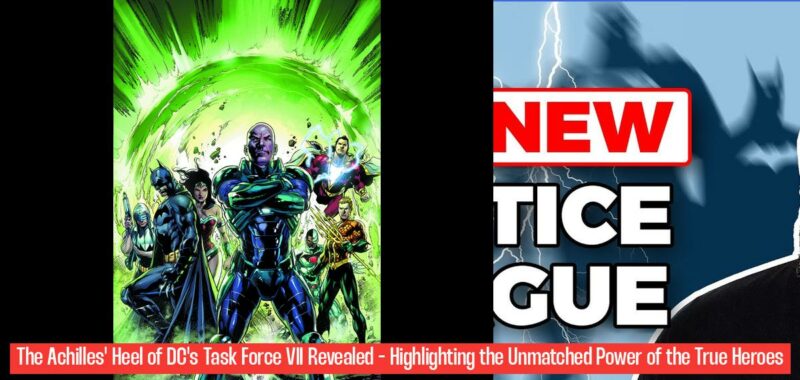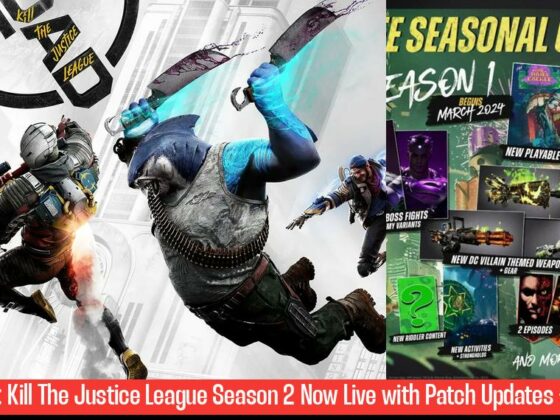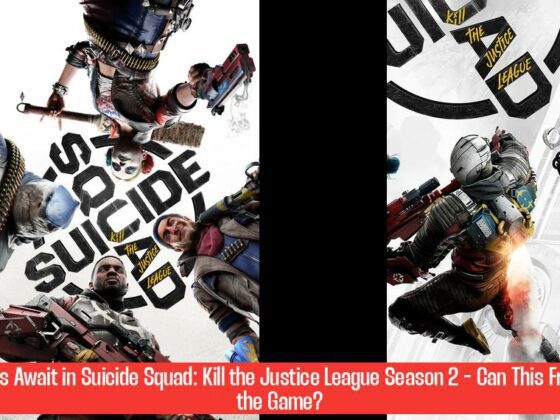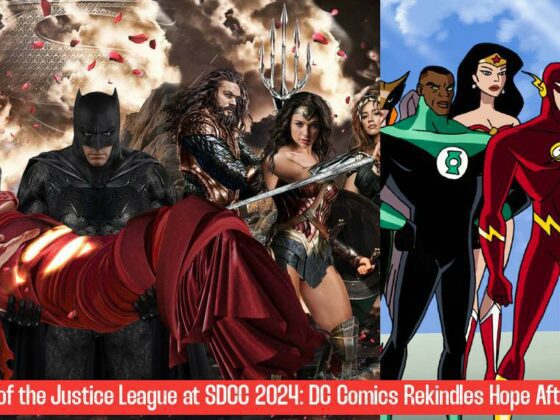DC’s Evil Justice League Replacements Are Hiding a Major Flaw – But It Confirms Just How Powerful the TRUE Heroes Are
The DC Universe has always been a battleground between good and evil. The Justice League, the world’s greatest superheroes, have stood as a beacon of hope against the forces of darkness. But in recent times, a new threat has emerged – Task Force VII, a group of powered individuals known as the “Evil Justice League” designed to act as replacements for the Justice League if they ever become a liability. However, these villains, despite their impressive abilities, are hiding a major flaw that could prove to be their undoing.
These replacements, powered by Amanda Waller’s formidable power-stealing AMAZO robots, have revealed a vulnerability that the Justice League could use to their advantage. This vulnerability, which highlights the true strength of DC’s heroes, raises the intriguing possibility of Task Force VII turning against their own creator, Amanda Waller.
The Weakness of Task Force VII: A Flaw in Their Design
The core of Task Force VII’s power lies within the AMAZO robots, machines designed to absorb and replicate the powers of the Justice League. Despite their impressive strength and abilities, these robots possess a critical flaw: they can only absorb and replicate power so long as they maintain a constant connection to Amanda Waller’s control center. This dependence on Waller’s technology makes them susceptible to manipulation and potential disruption.
Imagine a scenario where one of the Justice League members, like Batman, manages to hack into Waller’s control center. By disrupting the connection between the AMAZO robots and the control center, Task Force VII’s powers could be instantly nullified. This vulnerability exposes a critical flaw in their design and presents a prime opportunity for the Justice League to turn the tide in their favor.
The dependence on Waller’s control center also exposes Task Force VII to a potentially devastating psychological vulnerability. Imagine a scenario where the Justice League manages to convince one of the Task Force VII members, perhaps someone with a moral compass, that Waller is using them for her own selfish agenda. This could lead to an internal revolt, with the individual turning against their own team and potentially sabotaging the entire operation.
This reliance on a single source of control also paints a picture of a team that is not truly independent. They are merely puppets, dancing to the tune of Amanda Waller’s commands. This lack of autonomy could lead to internal conflicts and ultimately sow the seeds of dissent within the team.
The Strength of the True Heroes: A Testament to Their Resilience
The vulnerability of Task Force VII emphasizes the true strength of the Justice League. It showcases the resilience of the heroes, who have consistently overcome seemingly insurmountable odds throughout their long and storied history. The Justice League’s enduring strength is a testament to their unwavering commitment to justice and their ability to adapt and overcome any challenge.
This weakness in Task Force VII also highlights the importance of individual agency and self-reliance. The true heroes of the DC Universe are not bound by technological constraints or external forces. They are driven by their own internal compass and a strong sense of justice. This inherent strength makes them a formidable force, capable of taking on any threat, even those designed to mimic their powers.
The Justice League’s ability to overcome the challenge of Task Force VII would further solidify their position as the ultimate protectors of the DC Universe. It would demonstrate their adaptability, their strategic brilliance, and their unwavering commitment to upholding justice. This victory would serve as a powerful reminder that even the most formidable villains cannot truly replicate the essence of true heroism.
The Potential for Treachery: Task Force VII Turning Against Waller
The vulnerability of Task Force VII raises the intriguing possibility of the team turning against Amanda Waller. Motivated by a desire for self-preservation or a yearning for true freedom, the team could potentially rebel against their creator, seeking to break free from her control and forge their own destiny.
Imagine a scenario where a member of Task Force VII, maybe someone who has seen the true extent of Waller’s manipulative tactics, discovers the flaw in their design. This revelation could trigger a moral awakening, leading them to question their loyalties and ultimately choose a path of rebellion against their creator. This act of defiance could have far-reaching implications, potentially altering the balance of power within the DC Universe.
This potential for treachery underscores the complex nature of power dynamics within the DC Universe. It highlights the constant struggle between control and freedom, and the ultimate clash between those who seek to exploit power for personal gain and those who strive to use it for the greater good. The outcome of this potential conflict could determine the fate of the DC Universe, shaping the future of the heroes and villains alike.
The Importance of Moral Clarity: A Distinguishing Feature of True Heroes
The contrast between Task Force VII and the Justice League highlights the importance of moral clarity. The Justice League, despite their flaws, operate with a clear moral compass, guided by their unwavering commitment to justice. This moral framework distinguishes them from Task Force VII, who are merely instruments of Waller’s will, lacking any genuine sense of purpose or direction.
The Justice League’s unwavering commitment to justice has always been their defining characteristic. They are not driven by personal gain or ambition, but by a profound sense of duty to protect the innocent and fight for what is right. This unwavering moral compass has been the source of their strength and the foundation of their legacy.
Task Force VII, on the other hand, lacks this moral clarity. They are tools, instruments of Waller’s will, lacking any genuine commitment to justice or the greater good. Their actions are dictated by their programming, devoid of any true moral conviction. This lack of moral clarity ultimately weakens them, making them vulnerable to manipulation and potential betrayal.
The Future of Task Force VII: A Threat Yet to Be Fully Realized
The Justice League’s potential victory over Task Force VII does not signify the end of the threat they represent. The AMAZO robots, though flawed, are still incredibly powerful machines, and Waller’s ambition remains undeterred. The future of Task Force VII remains uncertain, and the threat they pose to the DC Universe is far from over.
The possibility of Task Force VII evolving and adapting to their weaknesses cannot be discounted. Waller, driven by her relentless pursuit of power, could potentially find ways to improve the robots, addressing their vulnerabilities and creating an even greater threat to the Justice League and the world.
The battle between the Justice League and Task Force VII is likely to continue, evolving into a complex and dynamic struggle for control over the future of the DC Universe. The outcome of this conflict will determine the fate of the heroes and villains alike, shaping the destiny of the world and the balance of power within the DC Universe.
Conclusion: A Testament to the Strength of True Heroes
The vulnerability of Task Force VII serves as a powerful reminder of the importance of true heroism. It highlights the resilience of the Justice League, their unwavering commitment to justice, and the inherent strength that comes from a clear moral compass. While the threat posed by Task Force VII remains real, the Justice League’s victory over this formidable force would serve as a powerful testament to their enduring strength and the enduring power of true heroism.
What is the major flaw that the Evil Justice League replacements are hiding?
The Evil Justice League replacements, powered by Amanda Waller’s AMAZO robots, have a critical flaw – they can only absorb and replicate powers as long as they are connected to Waller’s control center.
How could the Justice League potentially exploit the weakness of Task Force VII?
If a Justice League member like Batman were to hack into Waller’s control center, they could disrupt the connection between the AMAZO robots and the control center, instantly nullifying Task Force VII’s powers.
What psychological vulnerability does Task Force VII have due to their dependence on Amanda Waller’s control center?
The reliance on Waller’s control center exposes Task Force VII to the risk of internal revolt. If a member is convinced that Waller is manipulating them, they could turn against their own team, potentially sabotaging the operation.
How does the vulnerability of Task Force VII highlight the true strength of DC’s heroes?
The vulnerability of Task Force VII showcases the strategic prowess of the Justice League, emphasizing that their true strength lies not just in their powers but also in their ability to exploit weaknesses and turn situations in their favor.



